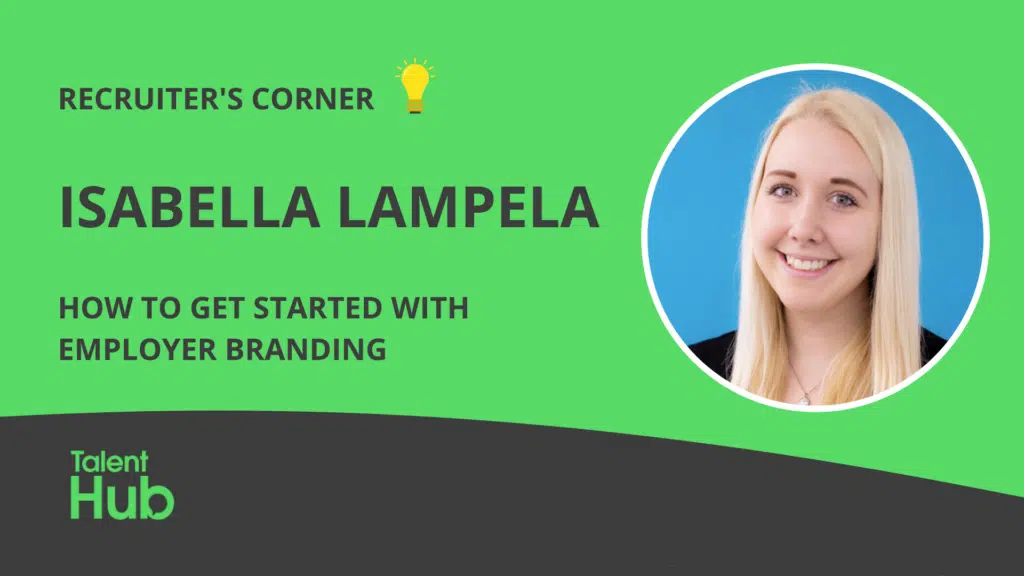Our third guest of the Recruiter’s Corner blog series is Isabella Lampela from Wolt. Having been involved in building the employer brand at Wise, Isabella boasts extensive experience in the industry.
In this article, we asked Isabella about what makes candidates switch jobs nowadays, what are some of the mistakes companies make when looking to hire new talent, as well as tips for how you can get started with employer branding as an early-stage start-up.
Let’s jump right into it!
Why did you choose employer branding as a career?
I got into employer branding by accident. At university, I was studying human resources management and marketing. I did an employer branding internship at a FinTech called Intuit in London. That was the moment I realized I could combine my passion for both of these fields. For me, it’s really interesting to deep-dive into the culture, values and ways of working of a company and package it up to candidates in engaging ways.
I worked at the FinTech Wise for three and a half years, where I was involved in building our employer brand up from scratch. It was an interesting journey to be involved in the end-to-end process — from building our employer value proposition and careers site, to running targeted recruitment marketing campaigns and optimizing our site for conversion.
My next challenge is building up the employer brand for our tech function at Wolt.
What makes candidates switch jobs nowadays?
It’s definitely the candidate’s market these days. Candidates are increasingly looking for roles that are meaningful, true to their values, and where they can have a real impact. That’s why it’s important to paint a realistic and honest image of what it’s like to work at your company. It’s important not to just sugarcoat, but also to openly talk about problems teams are working to solve and the challenges one might face when working in your company.
Companies aren’t one size fits all, so you shouldn’t sell your job opportunities like that either. Don’t just sell why your company is the right place for candidates, also tactfully tell them why it might not be the right fit. This way, you’re more likely to attract relevant candidates.
What are some of the most common myths around employer branding?
A common myth in my opinion is that employer branding is fluffy and can’t be measured. It’s true that measuring ROI of specific tactics into exact number of hires for example is difficult because the candidate journey can be very long. But it’s still possible to gather a lot of data besides the traditional vanity metrics like reach, clicks and follower amounts and link your metrics into candidate engagement data.
It’s best to create a holistic understanding of what tactics you’re implementing and what’s happening throughout the candidate funnel, not just at the attraction phase.
In your experience, what are the usual mistakes companies do with employer branding?
Employer branding has a reputation for being a bit fluffy — with masses of employees telling you how they love their job. In today’s climate, it’s not enough to attract candidates by describing the work as an everyday joy and your company being like a family.
When building an employer brand, you have to get into the specifics — what makes your company and its mission unique, what products are you building and why, and what’s the vision for the future and impact of the work you’re doing. Digging deeper is when you start to uncover what makes it special to work there.
As an early-stage start-up with 1-10 employees and no set values, how can you get started with employer branding?
When it comes to employer branding, word of mouth is crucial. So, instead of trying to do everything — fancy job ads, various social media accounts, blog posts — a helpful, scalable way to kick off would be to empower your current employees to talk about your company. You have to help them become ambassadors. This doesn’t mean telling them what to do and say, but rather giving them tools and inspiration to share the story, values and mission of your company with the external world.
And of course, there are marketing tactics that will come into play. But for example, on social media, the credibility and reach of individual employees combined can be much bigger than that of a company page.
Also, I’d focus on tactics where you can get to an already existing audience, rather than focusing on building your own social profile followership for instance. By for example getting your employees to talk at events, seminars and podcasts (and wherever your target audience might be!) you can tap into new audiences in a scalable way, rather than having to build up your own from scratch.
Do global companies need to have a different employer branding strategy for different markets? For instance, do you need to emphasize some perks more in Asia rather than Europe?
Of course it’s good to localize and better target your audience, but this also depends on your resources and the size of the employer branding team. If you’re a sole employer branding specialist at the company, it’ll be difficult for you to create separate strategies for all markets. I’d focus on building a global strategy that applies to various markets first. When you have the foundations in place, it’s easier to start tailoring your strategy and campaigns.
But if you have the resources to do that, it’ll definitely pay off — you can learn so much about the different employer branding channels that work in different markets.
What are some of the things that you can start doing immediately, as an employer, that will have an effect on your employer brand?
I’d first focus on building the narrative internally — what employer branding means, why it’s important and how your employees can contribute. Considering the power of word of mouth, I recommend creating a referral scheme that people know how to use in your company to leverage the power of their network. Besides that, I’d make sure your employees understand the key messages that they can share externally. It doesn’t have to be a full-on employer value proposition (EVP) mapping process if resources are tight, but mapping out what makes your company unique. From there, identify a couple of channels where you’ll get your messages across, whether that be through events, blogs, podcasts or social media.
Another recommendation would be to learn to speak the candidate’s language. You need to think about where your target audience spends their time. A lot of candidates might not actively be looking for jobs, so you need to find where they spend their time, go learn new things or communities they’re active in.
Try to step out of your marketing shoes and experiment with different things. Get your spokesperson on meetups, podcasts and don’t just talk about hiring. Hiring can sometimes be a sub-message within an interesting thought leadership piece or at the end of a technical talk at a meetup. One of the best ways to understand your audience is to spend time with and ask your current employees where they spend their time to gain new knowledge about their work.
In your experience, what are some of the most effective employer branding channels?
Especially for the tech audience I usually try to focus on high engagement tactics where you can get the attention of candidates for a longer period of time. Whilst tactics like paid social are still important, you can have someone’s attention for much longer if you get them to, for instance, listen to someone from your company featured in a podcast episode on an interesting industry topic.
And also word of mouth. Not just you shouting out about your company through the company profile, but nurturing and empowering your ambassadors. Getting your employees to talk about working at your company is a cheap, credible and organic way to get candidates interested. It’s important to mention though, that you first want to make sure your employees are happy. Sharing should never be forced in any way, it should always be authentic but you can make it as easy as possible for those who are interested to do it.
Do you have any funny employer branding stories to tell?
At Wise, we created a day-in-the-life video filmed from an employee’s point of view using a camera attached to a helmet. In the video (in my opinion) it looks pretty authentic but the helmet was big and clunky so the behind the scenes were really funny. We actually included a sneak peek of the helmet into the video as well at the end!
(c) Wise
What do you see as the next trends in employer branding?
Since the war for talent is crazy right now and it’s really the candidate’s market at the moment, I think it’ll push all of us in the industry to think more innovatively about the tactics we use and how we convey our key messages to the audience.
This will mean going beyond the traditional employer brand tactics. As an example at Wise we created a public product roadmap, visualizing what product features were being built at the company. Whilst it’s not specifically an employer branding activity, it ended up being interesting for our tech candidates as well. Product people love to know what they’d be building in the company, and we got really positive feedback about it from candidates.
What’s your next challenge in employer branding?
I really want to brainstorm and explore innovative ways to engage candidates. I’d love to explore tactics and elements that give a surprise element to candidates and improve the candidate experience. To do that, I first need to build the foundation and then dive deep into the minds of the target audience.
By Siim Pettai, Digital Marketing Specialist at TalentHub.



